Xing Hu
QiMeng-SALV: Signal-Aware Learning for Verilog Code Generation
Oct 22, 2025Abstract:The remarkable progress of Large Language Models (LLMs) presents promising opportunities for Verilog code generation which is significantly important for automated circuit design. The lacking of meaningful functional rewards hinders the preference optimization based on Reinforcement Learning (RL) for producing functionally correct Verilog code. In this paper, we propose Signal-Aware Learning for Verilog code generation (QiMeng-SALV) by leveraging code segments of functionally correct output signal to optimize RL training. Considering Verilog code specifies the structural interconnection of hardware gates and wires so that different output signals are independent, the key insight of QiMeng-SALV is to extract verified signal-aware implementations in partially incorrect modules, so as to enhance the extraction of meaningful functional rewards. Roughly, we verify the functional correctness of signals in generated module by comparing with that of reference module in the training data. Then abstract syntax tree (AST) is employed to identify signal-aware code segments which can provide meaningful functional rewards from erroneous modules. Finally, we introduce signal-aware DPO which is optimized on the correct signal-level code segments, thereby preventing noise and interference from incorrect signals. The proposed QiMeng-SALV underscores the paradigm shift from conventional module-level to fine-grained signal-level optimization in Verilog code generation, addressing the issue of insufficient functional rewards. Experiments demonstrate that our method achieves state-of-the-art performance on VerilogEval and RTLLM, with a 7B parameter model matching the performance of the DeepSeek v3 671B model and significantly outperforming the leading open-source model CodeV trained on the same dataset. Our code is available at https://github.com/zy1xxx/SALV.
SecureAgentBench: Benchmarking Secure Code Generation under Realistic Vulnerability Scenarios
Sep 26, 2025Abstract:Large language model (LLM) powered code agents are rapidly transforming software engineering by automating tasks such as testing, debugging, and repairing, yet the security risks of their generated code have become a critical concern. Existing benchmarks have offered valuable insights but remain insufficient: they often overlook the genuine context in which vulnerabilities were introduced or adopt narrow evaluation protocols that fail to capture either functional correctness or newly introduced vulnerabilities. We therefore introduce SecureAgentBench, a benchmark of 105 coding tasks designed to rigorously evaluate code agents' capabilities in secure code generation. Each task includes (i) realistic task settings that require multi-file edits in large repositories, (ii) aligned contexts based on real-world open-source vulnerabilities with precisely identified introduction points, and (iii) comprehensive evaluation that combines functionality testing, vulnerability checking through proof-of-concept exploits, and detection of newly introduced vulnerabilities using static analysis. We evaluate three representative agents (SWE-agent, OpenHands, and Aider) with three state-of-the-art LLMs (Claude 3.7 Sonnet, GPT-4.1, and DeepSeek-V3.1). Results show that (i) current agents struggle to produce secure code, as even the best-performing one, SWE-agent supported by DeepSeek-V3.1, achieves merely 15.2% correct-and-secure solutions, (ii) some agents produce functionally correct code but still introduce vulnerabilities, including new ones not previously recorded, and (iii) adding explicit security instructions for agents does not significantly improve secure coding, underscoring the need for further research. These findings establish SecureAgentBench as a rigorous benchmark for secure code generation and a step toward more reliable software development with LLMs.
Reasoning Efficiently Through Adaptive Chain-of-Thought Compression: A Self-Optimizing Framework
Sep 17, 2025Abstract:Chain-of-Thought (CoT) reasoning enhances Large Language Models (LLMs) by prompting intermediate steps, improving accuracy and robustness in arithmetic, logic, and commonsense tasks. However, this benefit comes with high computational costs: longer outputs increase latency, memory usage, and KV-cache demands. These issues are especially critical in software engineering tasks where concise and deterministic outputs are required. To investigate these trade-offs, we conduct an empirical study based on code generation benchmarks. The results reveal that longer CoT does not always help. Excessive reasoning often causes truncation, accuracy drops, and latency up to five times higher, with failed outputs consistently longer than successful ones. These findings challenge the assumption that longer reasoning is inherently better and highlight the need for adaptive CoT control. Motivated by this, we propose SEER (Self-Enhancing Efficient Reasoning), an adaptive framework that compresses CoT while preserving accuracy. SEER combines Best-of-N sampling with task-aware adaptive filtering, dynamically adjusting thresholds based on pre-inference outputs to reduce verbosity and computational overhead. We then evaluate SEER on three software engineering tasks and one math task. On average, SEER shortens CoT by 42.1%, improves accuracy by reducing truncation, and eliminates most infinite loops. These results demonstrate SEER as a practical method to make CoT-enhanced LLMs more efficient and robust, even under resource constraints.
Domain Adaptation in Agricultural Image Analysis: A Comprehensive Review from Shallow Models to Deep Learning
Jun 06, 2025Abstract:With the increasing use of computer vision in agriculture, image analysis has become crucial for tasks like crop health monitoring and pest detection. However, significant domain shifts between source and target domains-due to environmental differences, crop types, and data acquisition methods-pose challenges. These domain gaps limit the ability of models to generalize across regions, seasons, and complex agricultural environments. This paper explores how Domain Adaptation (DA) techniques can address these challenges, focusing on their role in enhancing the cross-domain transferability of agricultural image analysis. DA has gained attention in agricultural vision tasks due to its potential to mitigate domain heterogeneity. The paper systematically reviews recent advances in DA for agricultural imagery, particularly its practical applications in complex agricultural environments. We examine the key drivers for adopting DA in agriculture, such as limited labeled data, weak model transferability, and dynamic environmental conditions. We also discuss its use in crop health monitoring, pest detection, and fruit recognition, highlighting improvements in performance across regions and seasons. The paper categorizes DA methods into shallow and deep learning models, with further divisions into supervised, semi-supervised, and unsupervised approaches. A special focus is given to adversarial learning-based DA methods, which have shown great promise in challenging agricultural scenarios. Finally, we review key public datasets in agricultural imagery, analyzing their value and limitations in DA research. This review provides a comprehensive framework for researchers, offering insights into current research gaps and supporting the advancement of DA methods in agricultural image analysis.
QiMeng: Fully Automated Hardware and Software Design for Processor Chip
Jun 05, 2025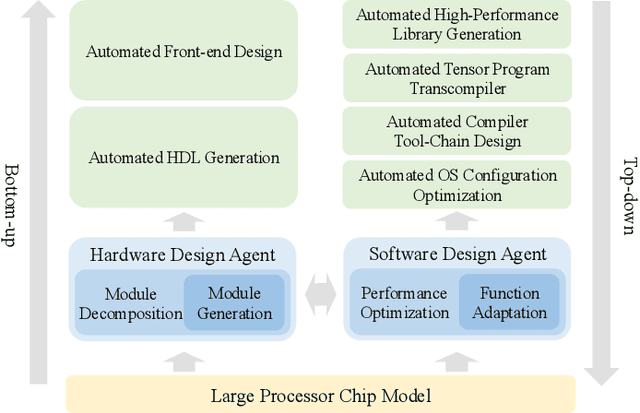
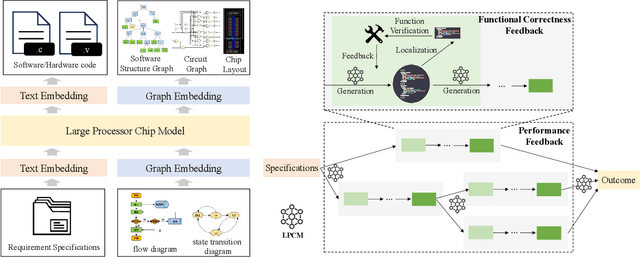
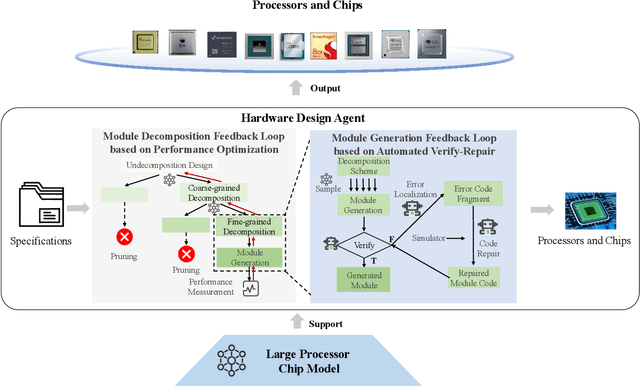
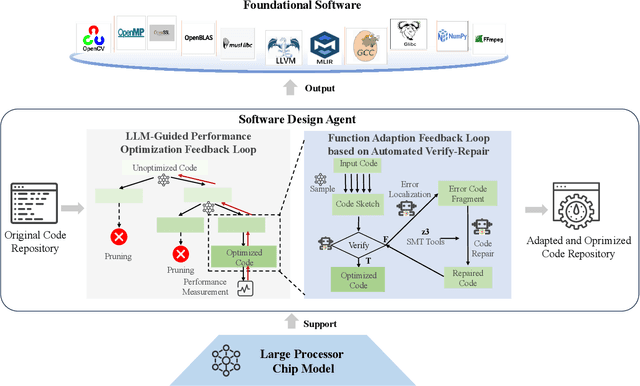
Abstract:Processor chip design technology serves as a key frontier driving breakthroughs in computer science and related fields. With the rapid advancement of information technology, conventional design paradigms face three major challenges: the physical constraints of fabrication technologies, the escalating demands for design resources, and the increasing diversity of ecosystems. Automated processor chip design has emerged as a transformative solution to address these challenges. While recent breakthroughs in Artificial Intelligence (AI), particularly Large Language Models (LLMs) techniques, have opened new possibilities for fully automated processor chip design, substantial challenges remain in establishing domain-specific LLMs for processor chip design. In this paper, we propose QiMeng, a novel system for fully automated hardware and software design of processor chips. QiMeng comprises three hierarchical layers. In the bottom-layer, we construct a domain-specific Large Processor Chip Model (LPCM) that introduces novel designs in architecture, training, and inference, to address key challenges such as knowledge representation gap, data scarcity, correctness assurance, and enormous solution space. In the middle-layer, leveraging the LPCM's knowledge representation and inference capabilities, we develop the Hardware Design Agent and the Software Design Agent to automate the design of hardware and software for processor chips. Currently, several components of QiMeng have been completed and successfully applied in various top-layer applications, demonstrating significant advantages and providing a feasible solution for efficient, fully automated hardware/software design of processor chips. Future research will focus on integrating all components and performing iterative top-down and bottom-up design processes to establish a comprehensive QiMeng system.
CodeV-R1: Reasoning-Enhanced Verilog Generation
May 30, 2025Abstract:Large language models (LLMs) trained via reinforcement learning with verifiable reward (RLVR) have achieved breakthroughs on tasks with explicit, automatable verification, such as software programming and mathematical problems. Extending RLVR to electronic design automation (EDA), especially automatically generating hardware description languages (HDLs) like Verilog from natural-language (NL) specifications, however, poses three key challenges: the lack of automated and accurate verification environments, the scarcity of high-quality NL-code pairs, and the prohibitive computation cost of RLVR. To this end, we introduce CodeV-R1, an RLVR framework for training Verilog generation LLMs. First, we develop a rule-based testbench generator that performs robust equivalence checking against golden references. Second, we propose a round-trip data synthesis method that pairs open-source Verilog snippets with LLM-generated NL descriptions, verifies code-NL-code consistency via the generated testbench, and filters out inequivalent examples to yield a high-quality dataset. Third, we employ a two-stage "distill-then-RL" training pipeline: distillation for the cold start of reasoning abilities, followed by adaptive DAPO, our novel RLVR algorithm that can reduce training cost by adaptively adjusting sampling rate. The resulting model, CodeV-R1-7B, achieves 68.6% and 72.9% pass@1 on VerilogEval v2 and RTLLM v1.1, respectively, surpassing prior state-of-the-art by 12~20%, while matching or even exceeding the performance of 671B DeepSeek-R1. We will release our model, training pipeline, and dataset to facilitate research in EDA and LLM communities.
CODE-DITING: A Reasoning-Based Metric for Functional Alignment in Code Evaluation
May 26, 2025Abstract:Trustworthy evaluation methods for code snippets play a crucial role in neural code generation. Traditional methods, which either rely on reference solutions or require executable test cases, have inherent limitation in flexibility and scalability. The recent LLM-as-Judge methodology offers a promising alternative by directly evaluating functional consistency between the problem description and the generated code. To systematically understand the landscape of these LLM-as-Judge methods, we conduct a comprehensive empirical study across three diverse datasets. Our investigation reveals the pros and cons of two categories of LLM-as-Judge methods: the methods based on general foundation models can achieve good performance but require complex prompts and lack explainability, while the methods based on reasoning foundation models provide better explainability with simpler prompts but demand substantial computational resources due to their large parameter sizes. To address these limitations, we propose CODE-DITING, a novel code evaluation method that balances accuracy, efficiency and explainability. We develop a data distillation framework that effectively transfers reasoning capabilities from DeepSeek-R1671B to our CODE-DITING 1.5B and 7B models, significantly enhancing evaluation explainability and reducing the computational cost. With the majority vote strategy in the inference process, CODE-DITING 1.5B outperforms all models with the same magnitude of parameters and achieves performance which would normally exhibit in a model with 5 times of parameter scale. CODE-DITING 7B surpasses GPT-4o and DeepSeek-V3 671B, even though it only uses 1% of the parameter volume of these large models. Further experiments show that CODEDITING is robust to preference leakage and can serve as a promising alternative for code evaluation.
Diffusion Model in Hyperspectral Image Processing and Analysis: A Review
May 16, 2025Abstract:Hyperspectral image processing and analysis has important application value in remote sensing, agriculture and environmental monitoring, but its high dimensionality, data redundancy and noise interference etc. bring great challenges to the analysis. Traditional models have limitations in dealing with these complex data, and it is difficult to meet the increasing demand for analysis. In recent years, Diffusion Model, as an emerging generative model, has shown unique advantages in hyperspectral image processing. By simulating the diffusion process of data in time, the Diffusion Model can effectively process high-dimensional data, generate high-quality samples, and perform well in denoising and data enhancement. In this paper, we review the recent research advances in diffusion modeling for hyperspectral image processing and analysis, and discuss its applications in tasks such as high-dimensional data processing, noise removal, classification, and anomaly detection. The performance of diffusion-based models on image processing is compared and the challenges are summarized. It is shown that the diffusion model can significantly improve the accuracy and efficiency of hyperspectral image analysis, providing a new direction for future research.
RWKVQuant: Quantizing the RWKV Family with Proxy Guided Hybrid of Scalar and Vector Quantization
May 02, 2025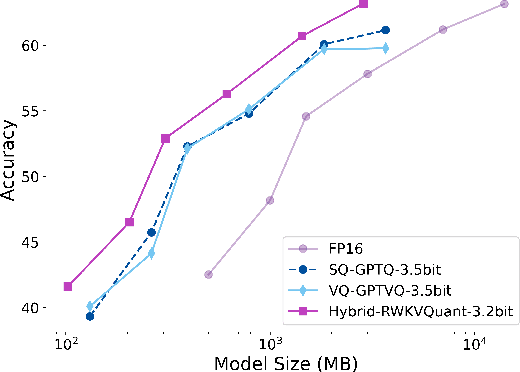
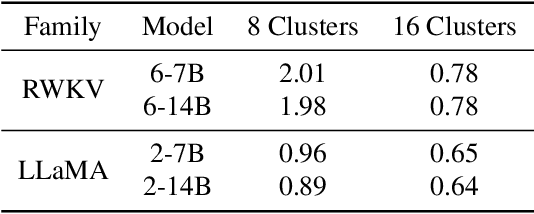
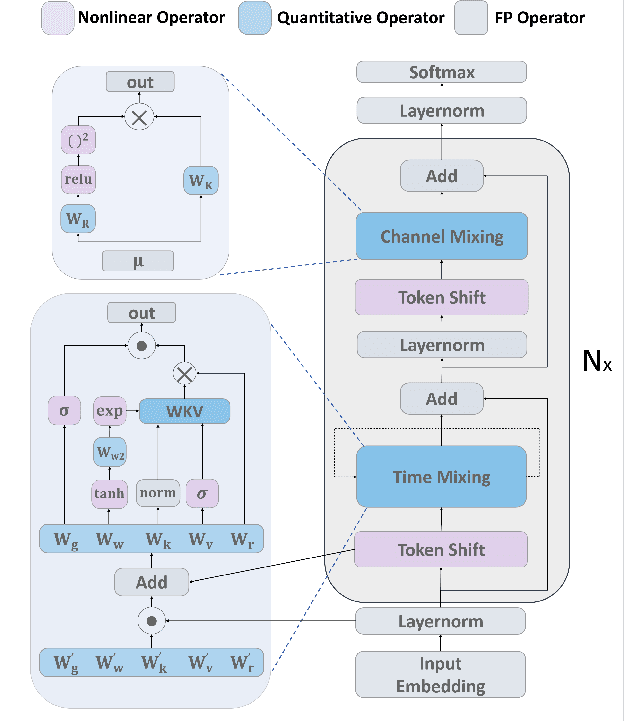
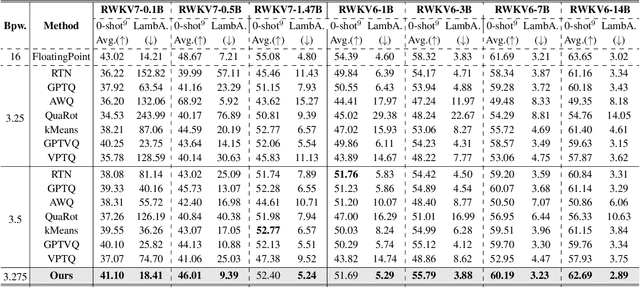
Abstract:RWKV is a modern RNN architecture with comparable performance to Transformer, but still faces challenges when deployed to resource-constrained devices. Post Training Quantization (PTQ), which is a an essential technique to reduce model size and inference latency, has been widely used in Transformer models. However, it suffers significant degradation of performance when applied to RWKV. This paper investigates and identifies two key constraints inherent in the properties of RWKV: (1) Non-linear operators hinder the parameter-fusion of both smooth- and rotation-based quantization, introducing extra computation overhead. (2) The larger amount of uniformly distributed weights poses challenges for cluster-based quantization, leading to reduced accuracy. To this end, we propose RWKVQuant, a PTQ framework tailored for RWKV models, consisting of two novel techniques: (1) a coarse-to-fine proxy capable of adaptively selecting different quantization approaches by assessing the uniformity and identifying outliers in the weights, and (2) a codebook optimization algorithm that enhances the performance of cluster-based quantization methods for element-wise multiplication in RWKV. Experiments show that RWKVQuant can quantize RWKV-6-14B into about 3-bit with less than 1% accuracy loss and 2.14x speed up.
MoEQuant: Enhancing Quantization for Mixture-of-Experts Large Language Models via Expert-Balanced Sampling and Affinity Guidance
May 02, 2025



Abstract:Mixture-of-Experts (MoE) large language models (LLMs), which leverage dynamic routing and sparse activation to enhance efficiency and scalability, have achieved higher performance while reducing computational costs. However, these models face significant memory overheads, limiting their practical deployment and broader adoption. Post-training quantization (PTQ), a widely used method for compressing LLMs, encounters severe accuracy degradation and diminished generalization performance when applied to MoE models. This paper investigates the impact of MoE's sparse and dynamic characteristics on quantization and identifies two primary challenges: (1) Inter-expert imbalance, referring to the uneven distribution of samples across experts, which leads to insufficient and biased calibration for less frequently utilized experts; (2) Intra-expert imbalance, arising from MoE's unique aggregation mechanism, which leads to varying degrees of correlation between different samples and their assigned experts. To address these challenges, we propose MoEQuant, a novel quantization framework tailored for MoE LLMs. MoE-Quant includes two novel techniques: 1) Expert-Balanced Self-Sampling (EBSS) is an efficient sampling method that efficiently constructs a calibration set with balanced expert distributions by leveraging the cumulative probabilities of tokens and expert balance metrics as guiding factors. 2) Affinity-Guided Quantization (AGQ), which incorporates affinities between experts and samples into the quantization process, thereby accurately assessing the impact of individual samples on different experts within the MoE layer. Experiments demonstrate that MoEQuant achieves substantial performance gains (more than 10 points accuracy gain in the HumanEval for DeepSeekMoE-16B under 4-bit quantization) and boosts efficiency.
 Add to Chrome
Add to Chrome Add to Firefox
Add to Firefox Add to Edge
Add to Edge